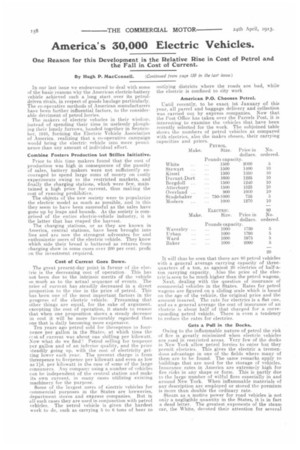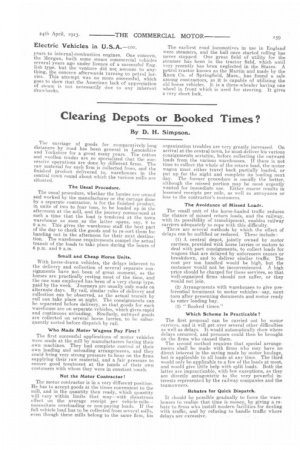America's 30,000 Electric Vehicles.
Page 12

Page 13

If you've noticed an error in this article please click here to report it so we can fix it.
One Reason for this Development is the Relative Rise in Cost of Petrol and the Fall in Cost of Current.
By Hugh P. MacConnell. (Continued /rom rage 130 in the last issue-)
In our last issue we endeavoured to deal with some of the basic reasons why the American electric-battery vehicle achieved such a long start. over its petroldriven rivals, in respect of goods haulage particularly. The co-operative methods of American manufacturers have been further influential factors, to the considerable detriment of petrol lorries. The makers of electric vehicles in their wisdom, instead of spending their time in uselessly ploughing their lonely furrows, banded together in September, 1910, forming the Electric Vehicle Association of America., realizing that a co-operative campaign would bring the electric vehicle into more pronnnence than any amount of individual effort.
Combine Fosters Production but Stifles Initiative.
Prior to this time makers found that the cost of production was high in consequence of the paucity of sales, battery makers were not sufficiently encouraged to spend large sums of money on costly experiments owing to the restricted markets, and finally the charging stations, which were few, maintained a high price for current, thus making the cost of running prohibitive. The objects of the new society were to popularize the electric model as much as possible, and in this they seem to have been successful as the sales have gone up by leaps and bounds. As the society is comprised of the entire electric-vehicle industry, it is the latter that has reaped the harvest.
The charging stations, or as they are known in America, central stations, have been brought into line and are now the strongest advocates for and enthusiastic users of the electric vehicle. They know which side their bread is buttered as returns from charging show in some eases over 200 per cent, profit on the investment required.
Cost of Current Goes Down.
The great present-day point in favour of the electric is the decreasing cost of operation. This has not been due to the intrinsic merits of the vehicle so much as to the actual sequence of events. The price of current has 'steadily decreased in a direct proportion to the rise in the price of petrol. This has been one of the most important factors in the progress of the electric vehicle. Presuming that other things are equal, for the sake of argument, excepting the cost of operation, it stands to reason that when one proposition shows a steady decrease in cost it will be more favourably regarded than one that is daily becoming more expensive. Ten years ago petrol sold for threepence to fourpence per gallon in the States, at which time the ccst of current was about one shilling per kilowatt. Now what do we find'? Petrol selling for tenpence per gallon and of an inferior quality, and the price steadily going up, with the cost of electricity getting lower each year. The present charge is from threepence to fivepence per kilowatt and even as low as Lid. per kilowatt in the case of some of the large consumers. Any company using a number of vehicles can be independent of the central station and make its own current, in many cases utilizing existing machinery for the purpose.
Some of the largestusers of electric vehicles for commercial purposes in the States are breweries, department stores and express companies. But in all such cases they are used in conjunction with petrol vehicles. The petrol vehicle is given the hardest work to do, such as carrying 5 to 6 tons of beer to outlying districts where the roads are bad, while the electric is confined to city work American P.O. Chooses Petrol.
Until recently, to be exact 1st January of this year, all parcel and baggage delivery and collection was carried out by express companies. Now that the Post Office has taken over the Parcels Post, it is interesting to examine the vehicles that have been recently selected for the work. The subjoined table shows the numbers of petrol vehicles as compared with electrics, also the makes chosen, their carrying It will thus be seen that there are 80 petrol vehicles with a general average carrying capacity of threequarters of a ton, as against 20 electrics of half-aton carrying capacity. Also the price of the electric is seen to be much higher than the petrol wagons.
Next, dealing with the question of insurance of commercial vehicles in the States. Rates for petrol wagons are figured on a sliding scale which is based on the age of the vehicle, the original price and the amount insured. The rate for electrics is a flat one, and as a general average the cost of insurance of an electric is about half of that charged for a corresponding petrol vehicle. There is even a tendency to reduce the rates for electrics.
Gets a Pull in the Docks.
Owing to the inflammable nature of petrol the risk of fire is greatly minimized when electric vehicles are used in restricted areas. Very few of the docks in New York allow petrol lorries to enter but they permit electrics. This gives the electric a tremendous advantage in one of the fields where many of them are to be found. The same remarks apply to buildings that are used for the storage of vehicles. Insurance rates in America are extremely high for fire risks in any shape or form. This is partly due to the large number of wilful fires especially in and around New York. When inflammable materials of any description are employed or stored the premium is more than double the ordinary rate.
Steam as a motive power for road vehicles is not only a negligible quantity in the States, it is in fact a dead letter. The greatest exponents of the steam car, the White, devoted their attention for several years to internal-combustion engines. One concern, the Morgan, built some steam commercial vehicles several years ago under licence of a successful English type, but the venture did not amount to anything, the concern afterwards turning to petrol lorries. This attempt was no more successful, which goes to show that the American lack of appreciation of steam is not necessarily due to any inherent drawbacks.
The earliest road locomotives in use in England were steamers, and. the ball once started rolling has never stopped. One great field of utility for the steamer has been in the tractor field, which until very recently has been neglected in the States. A petrol tractor known as the Martin and made by the Knox Co_ of Springfield, Mass., has found a sale among contractors, as it is capable of utilizing the old horse vehicles. it is a three-wheeler having one wheel in front which is used for steering. It gives a very short lock.
























